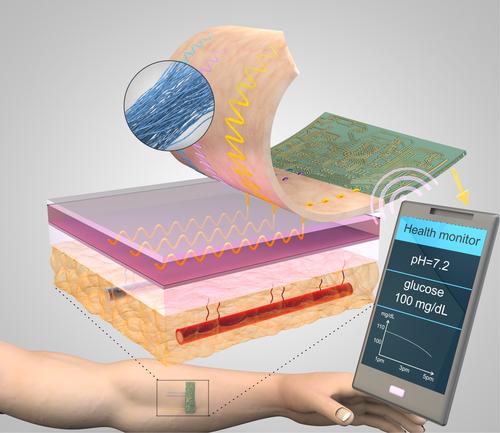'Smart,' Sensor-Infused Thread Can Gather Diagnostic Data from Human Tissue
July 22, 2016

Researchers have been developing a number of nano- and micro-scale technologies that can be used for implantable medical technology for the treatment of disease, diagnostics, prevention, and other health-related applications.
Now engineers at Tufts University have gone one step further with the invention of "smart" thread that actually can be woven into human tissue to collect diagnostic data, taking implantable technology to a whole other level.
Unlike typical implantable technology, which generally is localized to an area for a specific purpose, threads can access multiple layers of tissue to sample interstitial fluid and direct it to sensing threads that collect data, such as pH and glucose levels. The threads also can be conductive, which means they can deliver the data to a flexible wireless transmitter sitting on top of a person's skin.
"The ability to suture a thread-based diagnostic device intimately in a tissue or organ environment in three dimensions adds a unique feature that is not available with other flexible diagnostic platforms," said Sameer Sonkusale, director of the nterdisciplinary Nano Lab in the Department of Electrical and Computer Engineering at Tufts School of Engineering. "We think thread-based devices could potentially be used as smart sutures for surgical implants, smart bandages to monitor wound healing, or integrated with textile or fabric as personalized health monitors and point-of-care diagnostics."

Sonkusale told Design News the team was inspired to design the thread to treat chronic wounds, especially those due to the disease diabetes, which often go untreated and can lead to critical conditions.
"Chronic wounds due to diabetes are a serious burden on healthcare," he said. "We recognized a need to make sensors that monitor if wounds are healing and if there is infection."
Sonkusale said that since current sensor platforms are implemented on hard materials, they are impractical for placement inside human tissue. "Although there is a need to gather diagnostic data from deep within tissues, all current platforms are essentially limited to surfaces such as skin," he said.
The team set about creating flexible sensors that can reach wounds deep in the skin to gather physical and chemical information from tissues by embedding sensing devices within them, Sonkusale said. "Surprisingly threads provided us with the answer," he said. "The next step was to engineer these threads to perform the required sensing functions."
READ MORE ARTICLES ON MEDICAL TECHNOLOGY:
The team developed several threads to do this, each with its own purpose. Some transport fluids, some sense temperature and physical strain, and others sense pH and glucose, he said. To communicate the information to a mobile phone and the Internet, the team used a wireless transmitter that sits on top of the skin.
In addition to keeping track of wounds, other potential applications for the thread include being embedded into cardiac or orthopedic implants to communicate valuable diagnostic information about whether the implants are working correctly, or if there is any tissue scarring or inflammation due to the implant, Sonkusale said. "There is also direct application in making surgical sutures smarter so that doctors can monitor infection, swelling or inflammation post-op," he added.
The threads must undergo at least five to 10 years of rigorous testing before they could be used in human patients, Sonkusale said. In the meantime, the threads also could be embedded into bandages and on fabric to serve as a wearable diagnostic platform, he said. "For those applications we envision this technology could reach the market soon," Sonkusale said.
Researchers published a paper about their work in the journal, Microsystems & Nanoengineering.
Elizabeth Montalbano is a freelance writer who has written about technology and culture for more than 15 years. She has lived and worked as a professional journalist in Phoenix, San Francisco, and New York City. In her free time she enjoys surfing, traveling, music, yoga, and cooking. She currently resides in a village on the southwest coast of Portugal.
About the Author(s)
You May Also Like

.jpg?width=300&auto=webp&quality=80&disable=upscale)

